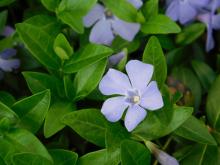Wildflowers, Grasses and Other Nonwoody Plants
Media

Species Types
Scientific Name
Asclepias incarnata
Description
Swamp milkweed has pink flower clusters at the tips of its tall stalks. The leaves are opposite, narrow, and up to 6 inches long. It grows in moist bottomland soils.
Media

Species Types
Scientific Name
Apocynum cannabinum
Description
Indian hemp is a shrubby, upright perennial with opposite branches and milky sap. This native plant can be a troublesome weed in crop fields and gardens, but Native Americans used its tough, fibrous stems for rope-making.
Media

Species Types
Scientific Name
Amsonia illustris
Description
Often found on gravelly Ozark streamsides, shining blue star lifts its clusters of showy, light-blue flowers in late spring. A top choice for native wildflower gardening, it is interesting spring, summer, and fall.
Media

Species Types
Scientific Name
Pyrrhopappus carolinianus
Description
One of several native plants called dandelions, Carolina false dandelion is an annual with sulphur yellow flowers and puffy seedheads.
Media

Species Types
Scientific Name
Lobelia cardinalis
Description
Cardinal flower provides a splash of bright red along streams and rivers, in bottomland forests, in ditches by roads, and in other wet places. It's a long-blooming Missouri native wildflower.
Media

Species Types
Scientific Name
Asclepias syriaca
Description
Common milkweed is famous as a food plant for monarch butterflies. It bears curious seedpods bearing seeds that fly on silky parachutes. It's common statewide in a variety of habitats.
Media

Species Types
Scientific Name
Vinca minor
Description
Common periwinkle is a low-growing, mat-forming, purple-flowering perennial that is woody at the base. Native to Eurasia, it is often grown as a groundcover. It has proven invasive in much of the eastern United States and frequently escapes from cultivation. Planting it is not recommended.
Media

Species Types
Scientific Name
Subfamily Asclepiadoideae
Description
Milkweeds are a group of plants that used to have their very own family. Now part of the dogbane family, they’re still a pretty distinctive group.
See Also
About Wildflowers, Grasses and Other Nonwoody Plants in Missouri
A very simple way of thinking about the green world is to divide the vascular plants into two groups: woody and nonwoody (or herbaceous). But this is an artificial division; many plant families include some species that are woody and some that are not. The diversity of nonwoody vascular plants is staggering! Think of all the ferns, grasses, sedges, lilies, peas, sunflowers, nightshades, milkweeds, mustards, mints, and mallows — weeds and wildflowers — and many more!





















